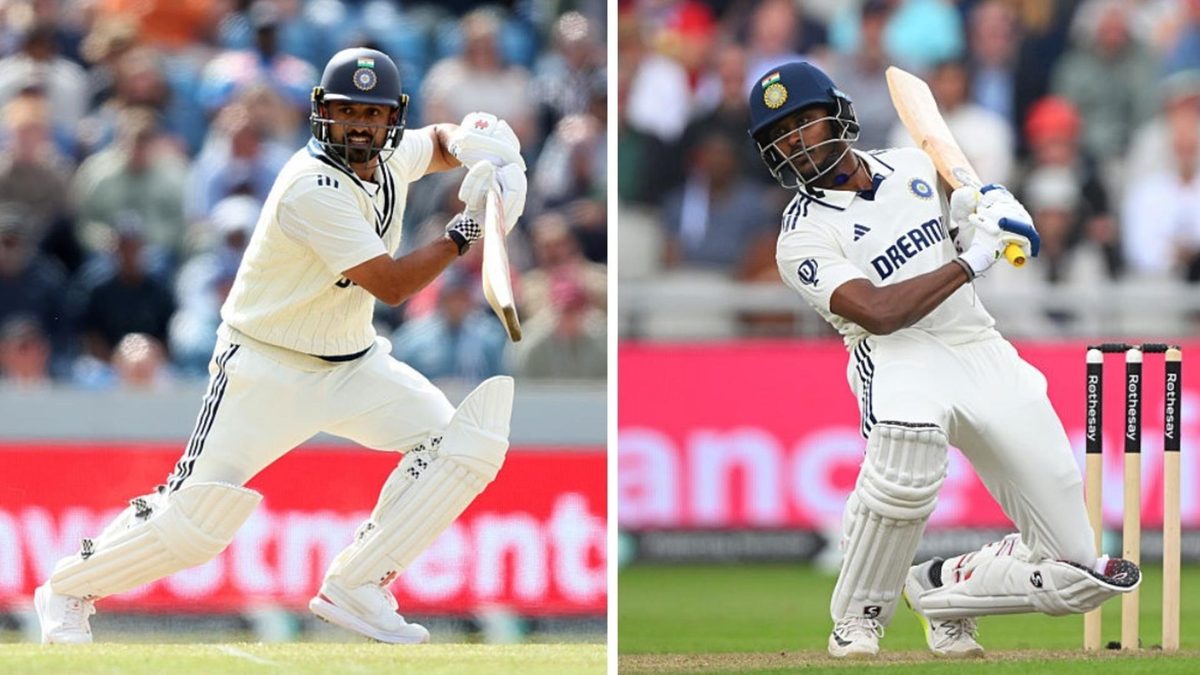
India made three changes to their playing XI for the fourth Test against England at Old Trafford. Two were forced, but the other – like several in the recent past – was quite head-scratching.
“We think Karun [Nair] is batting well. In the first match [at Leeds] he didn't really play at his number. It's difficult when a player is making a comeback in a series like this. But I don't think there's been any issue with his batting. He's been batting well.
“Sometimes it's also about getting that click. You know, once you're able to make your 50, then you're able to get back in your zone and get some big runs. Unfortunately that hasn't happened for him so far, but we are hopeful that he will be able to turn it around.”
A day out from the Old Trafford Test, Shubman Gill provided a firm backing of Karun Nair in the post-match press conference.
Less than an hour later, B Sai Sudharsan was photographed in the middle of a soaking wet ground, shadow batting in bare feet; a regular pre-match ritual for him. Less than 12 hours after Gill's press conference, reports began to emerge that Sai Sudharsan would replace Nair at No.3 for the fourth Test, and less than 24 hours after it, those reports were confirmed.
This was India’s second change at No.3 in this series, taking the count to eight in 12 Test matches. Starting with the 2024 New Zealand series at home, India have used Virat Kohli, Gill, Devdutt Padikkal, KL Rahul, Nair and Sai Sudharsan at that position, at times switching after one match.
India ended up batting first at Old Trafford, and as it happened, Sai Sudharsan batted 151 balls for his 61; the longest innings and highest score by an Indian No.3 in the last nine Tests.
But this is about processes, not outcomes.
Leave aside for a moment the public backing of Nair before his dropping: this is not unheard of in cricket. The way that India have approached the selection of their problem area in the batting lineup is almost painfully reactionary.
To recap the events: India began the series with both Sai Sudharsan and Nair in the lineup, at No.3 and No.6 respectively. They scored 0 and 30, and 0 and 20. For the next Test, Sai Sudharsan was dropped, Nair batted at three and Nitish Kumar Reddy came in at six. This was the combination for the third Test as well. Across his four outings at first drop, Nair did not cross 40 in any innings and found himself replaced at Old Trafford.
Nair had batted at No.3 in the warm-up matches against England Lions, which Sai Sudharsan missed, and even got himself a double hundred. If India were confident enough to look past all this, and confident enough in Sai Sudharsan's long-term potential to give him a debut instead, dropping him after one match made little sense.
Read more: Sanjay Manjrekar: 'Unfair' dropping after Test debut dented Sai Sudharsan's confidence
At the same time, if India were willing to give Nair the allowance that No.6 was not his position, giving him only two Tests at No.3 was not much better – and this after he had largely looked solid, and been the victim of a few unfortunate dismissals.
The other potential explanation for Nair's backing after the first Test is that India wanted to reward a player who had gone through the grind of domestic first-class cricket the previous seasons (something the BCCI made clear was a priority earlier this year), and/or not leave a youngster in the spotlight. With that rationale, Nair's dropping after two more Tests remains a strange decision.
At this point, it's most likely that neither player is entirely sure where they stand with respect to their spot, and even worse for the team, they probably haven't quite had a good look at either at Test level – to decide whether Sai Sudharsan can be their long-term No.3, or whether Nair, at 33, has enough in him to replicate his recent domestic form, and give them a couple of good series.
This, unfortunately, is the sort of muddled thinking, that has almost characterised the Indian Test side over the last 12 months or so.
During the New Zealand series at home, India picked R Ashwin, Ravindra Jadeja and Axar Patel as spin-bowling all-rounders. After they lost the first Test in Bengaluru, Washington Sundar was parachuted into the side the day after he scored 152 from No.3 in a Ranji Trophy game, and he played over Axar in Pune and Mumbai. India assistant Ryan ten Doeschate did say later that Sundar was preferred for his off-spin against New Zealand's left-handers.
It was also after the Bengaluru loss that Gautam Gambhir said, referring to fan sentiment around Rahul's performances, “Social media doesn't decide the playing XI. This team management is looking to back him.” In Pune the following day, it was Rahul who made way for Gill's return.
Even earlier on in the ongoing tour, India had asked 'A' team pacer Harshit Rana to stay back with the main squad, as cover for a player that had a niggle. With an uninspiring two Tests under his belt, as well as the availability of Anshul Kamboj, who had outbowled Rana in the A team's two matches against England Lions, that decision was met with some consternation among pockets of the Indian fanbase.
But once again, seemingly having made the decision to push Rana to the front of the queue, they went back on it and called Kamboj up for the fourth Test, after Akash Deep and Nitish Kumar Reddy were injured.
Rana's two Tests in Australia last year were, as mentioned, not hugely impressive. Arguably, it was the right call to not even put him in the firing line at first. India seemed willing to look past that when they retained him as cover for the Leeds Test here. But having done so, they did not seem fully convinced by their own decision.
These are the kind of decisions that have almost followed Gautam Gambhir around during his tenure as India's Test coach. If there has been any constant amidst this back-and-forth, it has been this: India will opt for a greater chance of runs than wickets at No.8. While that is a strategy that has its drawbacks, it at least shows that the current team management is capable of sticking to their guns when they wish to.
Also read: India's misuse of new-ball dependent Shardul Thakur is a blunder of selection and tactics
Whether India's team selections over the last year are right or wrong is not the immediate concern. Indeed, it's hard to argue that, for example, it was a bad idea to play Sundar against New Zealand, or that Kamboj should not have been selected ahead of Rana. Rather, it's the seeming lack of conviction in their own calls that jars. With the speed at which they pivot from one plan to the next, it's a miracle that no one has suffered metaphorical whiplash; and it appears to be almost purely outcome-based, an ill-advised philosophy.
India and Gambhir have a simple question in front of them: what do they want?
The answer, it seems, is rather more complex.
Follow Wisden for all England vs India updates, including live scores, latest news, team lineups, schedule and more. The live streaming details for the ENG vs IND series in India, UK, USA and rest of the world can be found here. For Wisden quizzes, head here.








